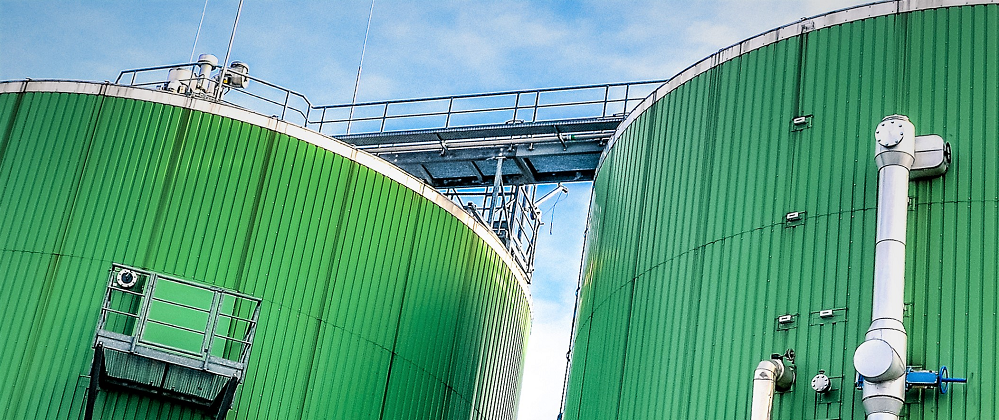Process upsets and failures of anaerobic digesters (AD) present significant headaches for owners and operators. Besides an immediate loss in biogas or RNG production and revenue loss, upsets and failures can result in serious safety risks and generate offensive odors. In turn, these can cause community complaints and attract greater scrutiny from regulators.
Digester operators can help safeguard their AD plant performance by improving awareness of the most overlooked causes of digester failure. Based on more than 30 years experience with digester facilities, this article presents the top five commonly overlooked causes of digester failure so you can recognize and avoid these pitfalls.
Recycle Streams
Recycle streams are probably the most overlooked aspect of anaerobic digestion processes. These relatively small flows can often carry a substantial quantity of interesting chemistry and biology that have caused costly upsets. Examples of recycle streams are:
- Digestate water from a solids press or filtration step being recycled to hydrate biomass solids, municipal source separated organic (SSO) wastes, or other dry feedstocks;
- Treated effluent from a digestate wastewater treatment process being recycled to manage the solids content or moisture level in the digester; and
- Undigested solids recycled back into an anaerobic digester for further biodegradation and biogas production.
Recycle streams can harm a digester by causing the accumulation of inhibitory or inert materials, such as the following:
- Ammonia-Nitrogen: When organic nitrogen in feedstocks is degraded, it is released into the water and measured as total ammonia-nitrogen (TAN), which measures both the ammonium (NH4+) and ammonia (NH3) forms. Ammonia (NH3) is highly inhibitory to digesters, with concentrations of 100 mg NH3-N/L being significantly inhibitory to methane production. In most digesters that do not have recycle streams, the TAN concentration usually remains low-enough that ammonia inhibition is not a concern. However, if nitrogen rich liquid effluent is recycled to hydrate dry feedstocks, then there is a risk of ammonia building up, leading to an ammonia-driven upset and failure.
- Salts: Salts, such as potassium, sodium, and chloride play an important role in biology. Large amounts of salts, however, are inhibitory to some microbes, including those in anaerobic digesters. Since salts are not destroyed in the digester, liquid recycle streams will bring the salts right back into the digester, leading to a salt build-up in the digester, and also ultimately lead to biological upsets.
- Inert Colloidal Solids: As organic material is broken down in the digester, some by-products are very small, non-biodegradable particles: inert colloids. These particles are difficult to remove without chemical treatment. Therefore, recycle streams can contain large amounts of colloids, which get recycled back to the digester. Large build-ups of inert solids occupy reactor volume, reducing the digester’s treatment performance, and ultimately lead to a wide range of biological or mechanical upsets.
The easiest option may be to avoid having the recycle at all, if practical. Or, be sure the facility process design considers the impact of recycle streams during the project development stages.
Nutrient Deficiencies
Poor nutrition is detrimental to the long-term health of anaerobic digesters. Fortunately, most digesters don’t have any nutritional deficiencies.
Digesters that take manure, biosolids (sewage sludge), or complex food waste feedstocks typically do not require any nutritional supplementation. Those digesters that do require nutrient supplements are usually taking a small number of feedstocks such as high fat wastes or agricultural residues that are lacking in nutritional value.
Many trace metals, such as cobalt, iron, nickel, and molybdenum, play key roles in metabolic functions of the digester biology. These trace metals can come from either from the digester feedstocks or from nutritional supplements. A deficiency of even one of these trace metals can significantly hamper biogas production and lead to further upsets.
Less extreme cases of nutrient deficiencies typically present simply as underperforming digesters. In these cases, you see feedstocks being only partially degraded in the digester, with low biogas output, and an unusually odorous digestate. In more extreme cases, nutrient deficiencies can lead to high organic acid accumulation and subsequent upsets caused by acidification.
Just like a person’s diet, a digester needs a good mix of feedstocks providing the fuel value for the biogas and the nutrients that allows the biology to unlock that fuel value.
Over-Acidification
Over-acidification is caused by a build-up of volatile fatty acids (VFAs). The build-up of VFAs is caused by the methane producing microbes that convert VFAs into methane being unable to keep up with how fast the VFAs are produced by the hydrolyzing and fermenting microbes. Build-up of VFAs and pH drop will hamper the methanogens further, worsening the problem. If the VFA accumulation is not halted, the digester will eventually be unrecoverable.
There are two main ways to avoid VFA accumulation:
- Watch for digester overfeeding: When a digester is stable, the methanogens are in balance with the hydrolyzing and fermenting bacteria and can convert the VFAs generated, keeping the VFA concentration stable. If the feeding rate is increased significantly, the hydrolyzing and fermenting bacteria will produce more VFAs than the methanogens can handle, as a result, the VFAs will build up in the digester. The VFA build up then causes the pH to drop, which will further inhibit the methanogens, and the digester will become upset.
- Inhibition of the Methanogens: Methanogens can be inhibited by any number of factors: ammonia accumulation, heavy metal toxicity, and large temperature or pH shifts, to name a few. If any of these occur, the VFA-to-methane conversion rate will drop and VFAs will begin accumulating. If the inhibition is not reversed or the feeding rate is not reduced until the methane bacteria recover, the VFA build-up and pH drop will worsen, and the digester will become upset.
Fortunately, in most cases, VFA build-ups are slow, so frequent and accurate measurements of VFA, alkalinity, and pH can catch this problem before it becomes critical.
Seasonal Heating & Cooling Demands and Weather Challenges
Digesters operating in cold climate areas face challenges during the winter with sustained freezing temperatures. Similarly, in warm areas, digesters can become too warm during sustained hot weather.
If the digesters are not properly designed, maintaining an optimal temperature of 95-100°F (35-38°C) could prove difficult, which will hamper biogas production. Typically, any temperature shift beyond 2-3°F (1-2°C) per day will disrupt biogas production due to the sensitivity of methanogens.
Digester heating, including warming frozen feedstocks, needs to accommodate worst-case winter conditions. Similarly, cooling systems need to be able to operate during extreme summer hot periods.
Cold weather can also present mechanical challenges. Screw augers for solid feeders can become inoperably frozen, preventing further feeding until they can be thawed out. This issue has been handled historically by flushing the screw auger systems with warm digestate to keep the material from freezing. Moisture in raw biogas pipelines can also become frozen at sensors and dead-legs, causing cracks in biogas pipelines.
Conversely, hot weather can lead to digester over-heating challenges. Hot weather can be more challenging to deal with than cold-weather heat loss, as many digesters are not built with any kind of cooling system. The biological heat generation from the biodegradation activity within the digester can be a significant heat contributor to be considered in the overall digester design work.
Under-appreciation of AD Parameter Variability
As a biological system, anaerobic digesters are dynamic and adaptable to change, but their adaptability depends on how fast the changes occur. When monitoring the key parameters, understanding the difference between sensor or sample noise and significant changes of concern is necessary to understand when and how to respond.
Temperature, pH, VFA, and alkalinity measurements will produce a significant amount of data noise, due in part to the high solids content of digestate and feedstocks. As a result, these parameters are rarely the same from day-to-day. When these fluctuations are small, within 10% of the long-term average, they can generally be considered stable. For example, an increase in VFAs from 2,000 mg/L to 2,200 mg/L the next day is not of concern, as it may be measured at 2,000 mg/L the day after that. However, if overall increasing trend continues, reaching 3,000 to 4,000 mg/L, that’s an indication of a VFA build-up that warrants investigation.
Large changes in temperature and pH can lead to upsets as well, disrupting biogas production, and if not corrected, these upsets may become unrecoverable. Significant pH shifts can also lead to upsets but are generally more an indicator of some other issue, such as an acid accumulation.
Conclusion
Understanding and avoiding upsets begins with getting a complete and accurate picture of the digester itself. What’s going in, what’s coming out, and what’s happening inside.
Authors:
David Ellis, MASc., PEng., Principal Engineer
James Arambarri, MASc., Optimization Lead
Michael Nelson, PhD, Process Analysis Lead
*This article was first published in Issue 2 of Biomass Magazine.
Related Articles
Top 10 Things to Make Your Digester Biology Happy
Anaerobic digestion is a complex biological process that requires a great deal of nuance and subtlety to optimize its operation. This article looks at the 10 most critical aspects of AD and how to make them run for the best outcome. Read the full article.
Ammonia Control Strategies
If lab testing indicates that your digestate might contain too much ammonia, what can you do? There a number of steps to reduce problematic gasses in an anaerobic digester. Read the full article.
Get Insights from the Bioprocess Experts Right to Your inbox
Sign up to the Discover Digesters Newsletter to access Azura’s best practices, field-tested advice, and insights into the anaerobic digestion & industrial wastewater treatment industries.
By submitting this form, you are consenting to receive marketing emails from: Azura Associates. You can revoke your consent to receive emails at any time by using the SafeUnsubscribe® link, found at the bottom of every email. Emails are serviced by Constant Contact.

